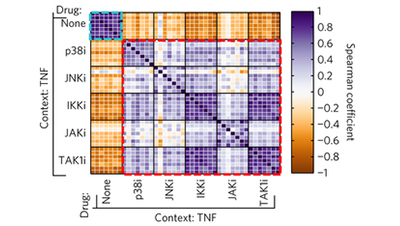Publication Summary
Profiling drugs for rheumatoid arthritis that inhibit synovial fibroblast activation
Douglas S. Jones1,2, Anne P. Jenney1, Jennifer L. Swantek3, John M. Burke3,4, Douglas A. Lauffenburger2, and Peter K. Sorger1
1HMS LINCS Center, Laboratory of Systems Pharmacology, Harvard Medical School, Boston, MA; 2Department of Biological Engineering, Massachusetts Institute of Technology, Cambridge, MA; 3Immunology and Inflammation, Boehringer Ingelheim, Ridgefield, CT; 4Systems Biology, Boehringer Ingelheim, Ridgefield, CT.
Nat Chem Biol (2017) 13(1):38-45.
doi:10.1038/nchembio.2211 / PMID:27820799
Synopsis
In the context of rheumatoid arthritis (RA), multiple kinase inhibitors partially block ligand-dependent synovial fibroblast (SF) activation and proinflammatory cytokine secretion into the synovial fluid, but the TAK1 inhibitor 5ZO is unique among the inhibitors tested in its ligand-independent efficacy across a panel of SFs isolated from RA patients.
Key findings
- Healthy SFs and RA SFs were similarly activated by TNF, IL-1α and poly(I:C) (a TLR3 agonist that mimics viral infection) such that they secreted a subset of the most abundant proinflammatory cytokines in the synovial fluid of RA patients.
- Multiple kinase inhibitors, including tofacitinib, partially blocked SF activation, but the magnitude of this effect was strongly dependent on the identity of the activating ligand.
- The TAK1 inhibitor 5ZO was unique among the compounds studied in that it blocked induced cytokine secretion in multiple donor samples regardless of the activating ligand.
Abstract
Activation of synovial fibroblasts (SFs) contributes to rheumatoid arthritis (RA) by damaging synovial membranes and generating inflammatory cytokines that recruit immune cells to the joint. In this paper we profile cytokine secretion by primary human SFs from healthy tissues and from donors with RA and show that SF activation by TNF, IL-1α, and polyinosinic-polycytidylic acid (Poly(I:C)) cause secretion of multiple cytokines found at high levels in RA synovial fluids. We used interaction multiple linear regression to quantify therapeutic and countertherapeutic drug effects across activators and donors and found that the ability of drugs to block SF activation was strongly dependent on the identity of the activating cytokine. (5z)-7-oxozeaenol (5ZO), a preclinical drug that targets transforming growth factor-β–activated kinase 1 (TAK1), was more effective at blocking SF activation across all contexts than the approved drug tofacitinib, which supports the development of molecules similar to 5ZO for use as RA therapeutics.
Explore the data
We encourage readers to explore the data underlying this study. The table below contains links to the relevant datasets in the HMS LINCS Database.
Available data
| Data | Secretion response of primary human synovial fibroblast samples from one healthy and one rheumatoid arthritis donor to a panel of 10 stimuli and 10 small molecule inhibitors (HMS Dataset #20233) | Detail | Download (.xlsx) |
| Data | Secretion response of seven primary human synovial fibroblast samples from healthy and rheumatoid arthritis donors to a panel of 3 stimuli and 5 small molecule inhibitors (replicate 1 of 2) (HMS Dataset #20234) | Detail | Download (.xlsx) |
| Data | Secretion response of seven primary human synovial fibroblast samples from healthy and rheumatoid arthritis-diagnosed donors to a panel of 3 stimuli and 5 small molecule inhibitors (replicate 2 of 2) (HMS Dataset #20235) | Detail | Download (.xlsx) |
Funding sources
NIH LINCS grant U54HL127365 to P.K.S., NIH grant P50-GM107618 to P.K.S., NRSA Fellowship 5F32AR062931 to D.S.J., and a sponsored research agreement dated 1 August 2009 from Boehringer Ingelheim Inc. to P.K.S. and D.A.L.
